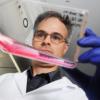Subject: Re: Autophagy
>I'd read that autophagy is attracting interest for
>anti-aging research, particularly for the elimination
>of defective/inefficient mitochondria. One main
>identifying characteristic of a defective mito is
>supposed to be the low charge potential across its
>membrane.
>
>One approach for preserving mitochondrial vigor I'd
>read about involves protecting mitochondrial DNA from
>being damaged by reactive oxidative species produced
>within the mito, by targetting them with a drug like
>Mito-Q or Mito-VitE. These agents apparently mate an
>anti-oxidant with a large lipophilic cation, in order
>to directly target mitochondria for anti-oxidant
>delivery.
>
>Similarly, the low membrane potential of defective
>mitochondria presents the opportunity for possible
>targetting with mitotoxic agents in order to
>selectively eliminate them and leave behind a
>population of relatively healthy mitochondria.
>
>However, I am curious as to whether autophagic tagging
>of defective mitochondria might not be a superior
>approach over mitotoxic agents. The idea would be to
>somehow exploit that low membrane potential that is
>the hallmark of defective mitos, in order to
>selectively tag them for autophagic destruction.
>
>Do you have any awareness of what governs the tagging
>of defective organelles for autophagotic envelopment
>and destruction? How could tagging be controlled and
>directed to better target defective mitochondria, to
>improve the quality of an aging mitochondrial
>population?
Again, a good question. We have some idea how peroxisomes
are tagged, but not mitochondria. With peroxisomes the change in
nutrient conditions causes Pex3 to leave the organelle, and this
uncovers Pex14, which appears to be the direct tag. One paper has
identified Uth1 as a mitochondrial tag but I do not think the data
are convincing. But even if this was the tag it would probably not
help in regard to improving mitochondrial turnover.
It is thought that damaged mitochondria might be recognized
and preferentially removed by autophagy, for example to prevent the
need for apoptosis. But again, nothing is known about how a damaged
mitochondrion is detected. It seems to me that the issue might not
be in better tagging but in being able to activate autophagy at will
(and then shut it off at will) to drive routine elimination of
cytoplasm. Autophagy declines with age so being able to induce it
might provide the beneficial aspects including removal of part of the
mitochondrial population. True, this would not target specifically
defective mitochondria unless the autophagic system is able to select
them out (which is the hypothesis after all).
So as previously discussed, triggered spurts of autophagy would be a useful way to keep our cells in shape. But how often is often enough?
Imagine triggering an autophagy spurt every night by taking a pill before you go to bed. But how long does it take to regenerate fresh mitochondria? What are the relevant timelines here?
Hmm, I still want to know more about why autophagy is declining with age. Any further insights, people?












































